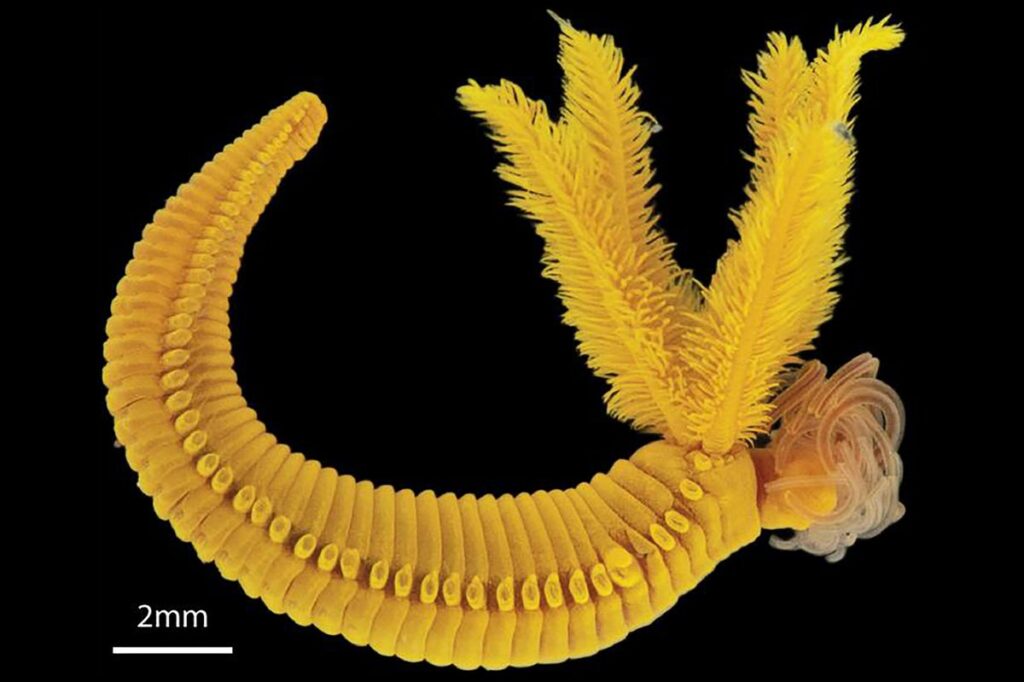August 28, 2025
2 min read
This Deep-Sea Worm Creates a Toxic Yellow Pigment Found in Rembrandt and Cézanne Paintings
A deep-sea worm that lives in hydrothermal vents is the first known animal to create orpiment, a toxic, arsenic-containing mineral that was used by artists for centuries
Paralvinella hessleri accumulates microscopic particles of arsenic on its outer skin, which reacts with sulfide to form a microscopic armour of yellow orpiment.
A bright-yellow worm that lives in deep-sea hydrothermal vents is the first known animal to create orpiment, a brilliant but toxic mineral used by artists from antiquity until the nineteenth century. The findings were published in PLoS Biology this week.
The worm (Paralvinella hessleri) is the only creature to inhabit the hottest part of deep-sea hydrothermal vents in the Okinawa Trough in the western Pacific Ocean. The hot, mineral-rich water that shoots up from the sea floor contains high levels of toxic sulfide and arsenic.
Researchers found that the worm accumulates microscopic particles of arsenic on its outer skin cells as well as along its internal organs. This reacts with sulfide from the hydrothermal vent to form small clumps of orpiment, fashioning a microscopic armour around the worm that protects it from the toxic environment.
On supporting science journalism
If you’re enjoying this article, consider supporting our award-winning journalism by subscribing. By purchasing a subscription you are helping to ensure the future of impactful stories about the discoveries and ideas shaping our world today.
Orpiment is a naturally occurring arsenic sulfide mineral, often found in hydrothermal and magmatic ore deposits.
The findings came as a surprise to the research group. In the deep sea, creatures dwell in total darkness and are typically grey-ish white or adorned in hues of orange to dark red, says co-author Hao Wang, a deep-sea biologist at the Chinese Academy of Sciences in Qingdao. It “doesn’t make any sense to make pigment in total darkness,” Wang says.
Unknown mechanism
The team is yet to discover how arsenic is transported into the creature’s internal organs.
Other deep-sea creatures are known to produce minerals as a protective armour. The scaly-foot snail (Chrysomallon squamiferum) for instance, hosts bacteria that detoxifies sulfide through the extracellular biomineralization of iron sulfides in its scales, says Narissa Bax, a marine scientist at Greenland Institute of Natural Resources in Nuuk.
“Paralvinella hessleri may intentionally combine toxins into a single, ‘safe’, crystalline mineral within its own cells,” she says. It’s ability to fight poison with poison in this way is remarkable, she adds.
But further research to confirm how this occurs will be challenging, owing to the extreme conditions in deep-sea vents, and difficulties studying such species outside their natural environments, she says. Cultivation of P. hessleri in a laboratory setting is currently not possible.
This article is reproduced with permission and was first published on August 28, 2025.
It’s Time to Stand Up for Science
If you enjoyed this article, I’d like to ask for your support. Scientific American has served as an advocate for science and industry for 180 years, and right now may be the most critical moment in that two-century history.
I’ve been a Scientific American subscriber since I was 12 years old, and it helped shape the way I look at the world. SciAm always educates and delights me, and inspires a sense of awe for our vast, beautiful universe. I hope it does that for you, too.
If you subscribe to Scientific American, you help ensure that our coverage is centered on meaningful research and discovery; that we have the resources to report on the decisions that threaten labs across the U.S.; and that we support both budding and working scientists at a time when the value of science itself too often goes unrecognized.
In return, you get essential news, captivating podcasts, brilliant infographics, can’t-miss newsletters, must-watch videos, challenging games, and the science world’s best writing and reporting. You can even gift someone a subscription.
There has never been a more important time for us to stand up and show why science matters. I hope you’ll support us in that mission.


